Tong Hao Glebionis coronaria (L.) Spach, formerly called Chrysanthemum coronarium L., is a member of the daisy family Asteraceae (Compositae), which also includes another common vegetable crop: lettuce (Lactuca sativa L.) grown in Florida. This species is native to China (Hong and Blackmore 2015) and Europe (Harrington and Harrington 2009). It is a traditional garden species in Europe and an important vegetable in Asia and Asian communities in other countries. It has been grown in China for more than 900 years (He et al. 2015). This vegetable is called Tong Hao. Other names for Tong Hao include Tanghao Cai in Mandarin, and Tahn Ho, Tango, Tong Ho Choy, Tung Ho Choy, or Chong Ho Choy, in Cantonese. It is named Gul-chini in India; Shigiku, Shungiku, or Kikuna in Japan; Ssukgat in Korea; and Tan or Tan O in Vietnam. In English speaking countries, Tong Hao is called crown daisy, garland daisy, edible chrysanthemum, garland chrysanthemum, or chrysanthemum greens.
Tong Hao is an erect and branched annual leafy herb (Figures 1–4) and is slightly aromatic. The plants may grow to a height of 1 to 3 feet and form dense stands. This herb has alternate leaves that are oblong to lanceolate and auricled in shape but clasping at the base. The leaves are 2 to 4 inches in length, bipinnate, lobed, and thick. The leaves of the small leaf varieties are narrow and deeply toothed. Flowering heads are solitary and white or yellow in color, 1 to 1.5 inches in diameter, and have long-peduncles. The floral heads terminate the branches. Like lettuce, this species has very small seeds. Usually, 1000 seeds of this crop weigh around 2 grams (Sainath et al. 2014).
If Tong Hao is grown in gardens and not managed, the dense stands can crowd out native vegetation, and dead plant mass can remain in place for a number of years preventing native plants from recolonizing.

Credit: Guodong Liu, UF/IFAS
There are two types of varieties of Tong Hao: broadleaf and narrow leaf. The former, with large and thick leaves, is more tolerant to hot weather. Thus, it is an excellent variety for Florida growers. It can be planted in March and harvested 40 to 45 days after planting. This leafy crop can be harvested once a week until late November and produce approximately 40,000 pounds per acre. The narrow leaf varieties, with small, narrow leaves that have deeply toothed divisions, are usually slightly greener than broadleaf varieties. Narrow leaf Tong Hao is adapted to be conducive to cool weather and may not be the best choice for a climate with hot temperatures. In north Florida, it can be grown from early September to March due to its tolerance of low temperatures. It can be harvested once a week starting in November.
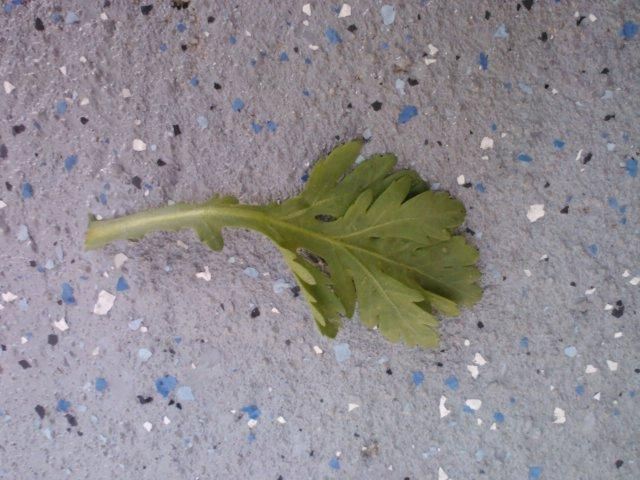
Credit: Guodong Liu, UF/IFAS
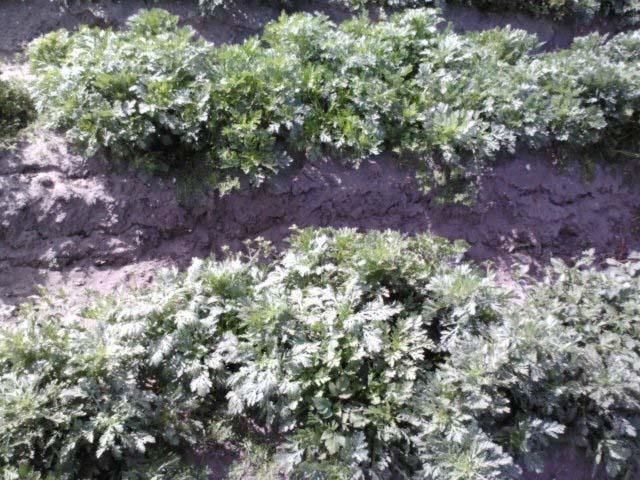
Credit: Guodong Liu, UF/IFAS
Tong Hao is rich in mineral nutrients and vitamins. Its ß-carotene content is greater than other vegetables (Table 1)— typically 1.5 to 30-fold greater than those levels in cucumber and eggplant. This leafy vegetable also contains various antioxidants. These antioxidants have potential health benefits for humans.
Alternately, Tong Hao can be used as a green manure. When incorporated into the soil, Tong Hao tissue can effectively control root-knot nematodes, Meloidogyne incognita and M. javanica, and thereby improve tomato yields under both greenhouse and field conditions (Olabiyi et al. 2011).
How to Grow Tong Hao
Tong Hao's optimum growth temperature ranges from 68 to 84°F; it grows well in partial shade conditions and prefers damp but well-drained soil. In Florida, Tong Hao can be produced in both spring and fall seasons. In south Florida, winter production is also possible (Stephens 1994). However, if grown in summer, it tastes slightly bitter because of the high temperatures. This crop prefers nutrient rich or humus soil conditions. At planting, the small seeds need to be thinly sown a quarter to a half inch deep. Plant spacing should be 2 inches with 18-inch row spacing (Harrington and Harrington 2009). When the seedlings approach a few inches tall, thinning may be needed. There is no UF/IFAS nutrient or crop management recommendations available yet for Tong Hao production. Accordingly, fertilizer management programs for this crop should, for the time being, follow the UF/IFAS recommendation for lettuce production, available in the Vegetable Production Handbook for Florida (https://edis.ifas.ufl.edu/publication/CV296, Liu et al. 2021).
How to Harvest Tong Hao
The crop can normally be harvested 40 to 45 days after sowing, when plants are approximately 8 inches tall. For the small leaf varieties, there is only a one-time harvest: cut the plants at the soil surface, clean, and pack for market. For the broadleaf varieties, both one-time and multiple harvests may be practiced. The one-time harvest method is the same as that for the small leaf varieties. For multiple harvests, the top parts of shoots are removed, leaving 1 to 2 branches or 4 to 5 basal leaves in the field.
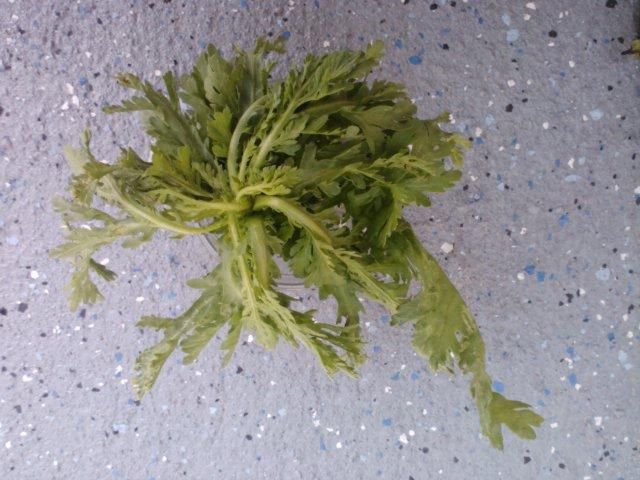
Credit: Guodong Liu, UF/IFAS
Flower Production
Tong Hao can also be grown as an ornamental crop because it has beautiful flowers. To grow the plant for flowers, it is necessary to thin out the row and leave enough space for plants to fully develop. Tong Hao plants bloom approximately 60 days after seeding (Harrington and Harrington 2009), and the showy flowers can be a beautiful addition to a garden.
How to Cook
Tong Hao has a unique chrysanthemum taste, which makes it popular in Chinese cuisine. Most Chinese people cook Tong Hao by stir-frying it alone (Figures 5–7) as a cooked vegetable dish. People from northern China prefer to combine Tong Hao with meat to create a stuffing used to make dumplings. People in southern China usually use it in hotpots, casserole, or soup. In Cantonese cuisine, a quick version of the Chinese hotpot, a soup mixed with shredded chicken or lean pork, is flavored by adding Tong Hao and soy sauce. Additionally, the tender leaves can be used raw in salads along with bean sprouts, other leafy greens, or tomatoes and tossed with sesame oil dressing.
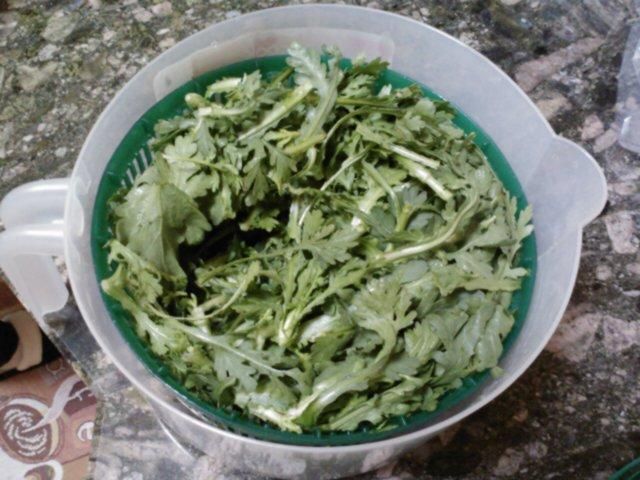
Credit: Guodong Liu, UF/IFAS

Credit: Guodong Liu, UF/IFAS
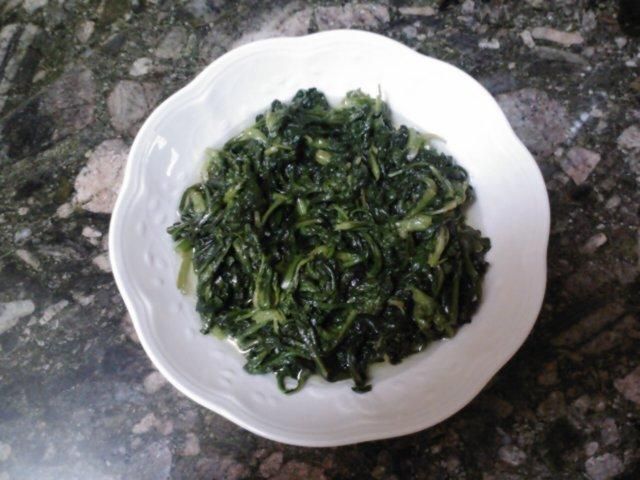
Credit: Guodong Liu, UF/IFAS
References and Further Reading
Harrington, G. and J. Harrington. 2009. Grow Your Own Chinese Vegetables. North Adams, MA: Storey Publishing.
He, S.-A., T.-S. Yi, S.-J. Pei, and H.-W. Huang. 2015. "Crop Plants and Their Wild Relatives." In: Plants in China: A Companion to the Flora of China, eds. De-Yuan Hong and Stephen Blackmore. New York: Cambridge University Press. pp. 283–308.
Liu, G. D., E. H. Simonne, K. T. Morgan, G. J. Hochmuth, S. Agehara, and R. Mylavarapu. 2021. Fertilizer Management for Vegetable Production in Florida. CV296. Gainesville: University of Florida Institute of Food and Agricultural Sciences. Accessed February 4, 2016. https://edis.ifas.ufl.edu/publication/CV296
Olabiyi, T.I., I.O. Adepoju, S.A. Abolusoro and E.E.A. Oyedunmade. 2011. "Suppression of Nematode Pests of Tomato with Aqueous Leaf Extracts of Nitta, Tobacco and Pawpaw." American-Eurasian Journal of Agronomy 4(2): 23–27.
Sainath, D.S.U, V.S. Patil, V.K. Deshpande, and R. Hunje. 2014. "Effect of different growth regulators on seed yield and quality attributes in annual chrysanthemum." Karnataka Journal of Agricultural Science 27(2): 123–134.
Stephens, J. M. 1994. Chrysanthemum, Edible—Chrysanthemum coronarium L. HS582. Gainesville: University of Florida Institute of Food and Agricultural Sciences. Accessed on June 9, 2022. https://edis.ifas.ufl.edu/publication/MV049
USDA-ARS. 2015. National Nutrient Database for Standard Reference Release 28, Full Report (All Nutrients) 11157, Chrysanthemum, garland, raw. Accessed February 3, 2016. https://fdc.nal.usda.gov/fdc-app.html#/food-details/169995/nutrients